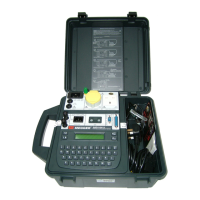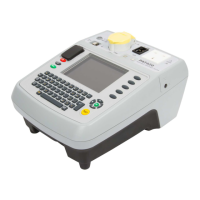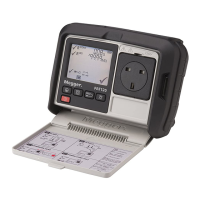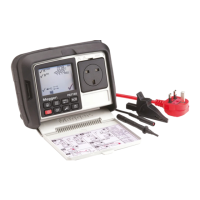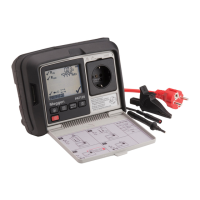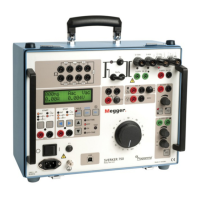Do you have a question about the Megger PAT410 and is the answer not in the manual?
Lists items included in the UK packaging for PAT400 series.
Lists items included in the European packaging for PAT400 series.
Lists essential safety warnings and precautions for using the instrument.
Icons indicating electrical hazards and the need for caution.
Symbols for EU compliance, electronic waste disposal, and battery type.
Icons for test lead position and warnings against mains connection.
Introduces the PAT400 series testers and operating requirements.
Identifies and describes physical components, controls, and display.
Describes the function of power, home, and escape buttons.
Explains the purpose of hotkey buttons for quick access.
Categorizes hotkeys based on their availability in Home, Setup, or other screens.
Describes the menu bar, main display, and additional menu option areas.
Explains using arrow keys, OK, HOME, and ESC for navigation.
Describes fields for manual text or number entry.
Describes fields with pre-defined lists of options.
Details the types of batteries and fuses used in the PAT400.
Provides steps for replacing battery and fuses, including warnings.
Instructions for connecting, powering on, and initial setup.
Details the options and sections available in the HOME screen menu.
Steps for a standard shutdown procedure of the instrument.
Explains the hibernation mode for quick restarts after power loss.
General instructions for connecting Class I/II assets, IEC cords, and 110V leads.
Describes methods to start testing using hotkeys or the TEST button.
Procedure for searching existing assets and adding new ones.
Shows the test progress screen and explains result indicators.
Explains when and how to use the remote probe, with an example.
Lists available actions after a test sequence is completed.
Procedure for logging visual failures, including notes and codes.
Provides a list of common repair codes and their descriptions.
Covers warnings for power-on tests, reversed supply, and earth faults.
Addresses warnings for parallel earth paths and full database.
Explains client/location structure and asset ID rules for memory storage.
Describes how to save asset data before or after testing.
Procedure for saving test results and printing barcode labels.
Steps to add asset information before performing tests.
How to copy existing asset data to create new entries.
Procedure to modify existing asset information.
Instructions for backing up instrument data to a USB drive.
Explains the purpose and provides steps for creating test groups.
Instructions on how to perform tests using the Quick Test function.
Covers adding, editing, and deleting client information.
Steps to add new location entries for a client.
Covers multiple operator accounts, login, and status.
Procedures for logging out and powering down the instrument.
Explains the difference between Supervisor and User account levels.
Procedure to change the default administrator account name.
Step-by-step guide to setting a PIN for an account.
Steps for recovering login access by clearing users.
How to activate reverse polarity testing for leakage tests.
How to enable/disable skipping PE bond testing.
Compares PAT400 features, storage, and Asset ID usage with PAT4.
Explains continuity and bond testing methods and their differences.
Specifies the acceptable input voltage and frequency ranges.
Details specifications for 10A and 25A bond tests.
Lists standard accessories included with the instrument.
Lists optional accessories available for purchase.
Precautions for handling sensitive internal components.
Details warranty and procedures for returning the instrument for service.
Lists items included in the UK packaging for PAT400 series.
Lists items included in the European packaging for PAT400 series.
Lists essential safety warnings and precautions for using the instrument.
Icons indicating electrical hazards and the need for caution.
Symbols for EU compliance, electronic waste disposal, and battery type.
Icons for test lead position and warnings against mains connection.
Introduces the PAT400 series testers and operating requirements.
Identifies and describes physical components, controls, and display.
Describes the function of power, home, and escape buttons.
Explains the purpose of hotkey buttons for quick access.
Categorizes hotkeys based on their availability in Home, Setup, or other screens.
Describes the menu bar, main display, and additional menu option areas.
Explains using arrow keys, OK, HOME, and ESC for navigation.
Describes fields for manual text or number entry.
Describes fields with pre-defined lists of options.
Details the types of batteries and fuses used in the PAT400.
Provides steps for replacing battery and fuses, including warnings.
Instructions for connecting, powering on, and initial setup.
Details the options and sections available in the HOME screen menu.
Steps for a standard shutdown procedure of the instrument.
Explains the hibernation mode for quick restarts after power loss.
General instructions for connecting Class I/II assets, IEC cords, and 110V leads.
Describes methods to start testing using hotkeys or the TEST button.
Procedure for searching existing assets and adding new ones.
Shows the test progress screen and explains result indicators.
Explains when and how to use the remote probe, with an example.
Lists available actions after a test sequence is completed.
Procedure for logging visual failures, including notes and codes.
Provides a list of common repair codes and their descriptions.
Covers warnings for power-on tests, reversed supply, and earth faults.
Addresses warnings for parallel earth paths and full database.
Explains client/location structure and asset ID rules for memory storage.
Describes how to save asset data before or after testing.
Procedure for saving test results and printing barcode labels.
Steps to add asset information before performing tests.
How to copy existing asset data to create new entries.
Procedure to modify existing asset information.
Instructions for backing up instrument data to a USB drive.
Explains the purpose and provides steps for creating test groups.
Instructions on how to perform tests using the Quick Test function.
Covers adding, editing, and deleting client information.
Steps to add new location entries for a client.
Covers multiple operator accounts, login, and status.
Procedures for logging out and powering down the instrument.
Explains the difference between Supervisor and User account levels.
Procedure to change the default administrator account name.
Step-by-step guide to setting a PIN for an account.
Steps for recovering login access by clearing users.
How to activate reverse polarity testing for leakage tests.
How to enable/disable skipping PE bond testing.
Compares PAT400 features, storage, and Asset ID usage with PAT4.
Explains continuity and bond testing methods and their differences.
Specifies the acceptable input voltage and frequency ranges.
Details specifications for 10A and 25A bond tests.
Lists standard accessories included with the instrument.
Lists optional accessories available for purchase.
Precautions for handling sensitive internal components.
Details warranty and procedures for returning the instrument for service.
| Type | Portable Appliance Tester |
|---|---|
| Test Voltage | 250V, 500V |
| Display | LCD |
| Power Supply | Battery |
| Power Supply Voltage | 6V |
| Protection Rating | IP54 |
| Operating Temperature Range | -10°C to +50°C |
| Earth Bond Test Current | 25 A AC |
| Battery Type | Alkaline |
| Dimensions | 100 mm |


